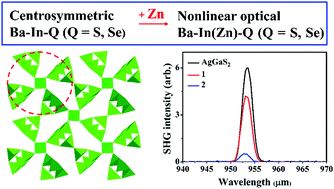Ba13In12Zn7S38 and Ba12In12Zn8Se38: infrared nonlinear optical chalcogenides designed by zinc-induced non-centrosymmetry transformation†‡
Abstract
Drawbacks, such as low laser damage threshold (LDT), of existing IR nonlinear optical (NLO) materials necessitate the exploration of new candidates. Promising candidates should have been found in the Ba–In–Q (Q = S, Se) system close to the well-known IR NLO (Ba, Sr)–(Ga, Al)–Q system, but all known Ba–In–Q phases are centrosymmetric (CS), precluding them from being NLO-active. Two new chalcogenides, Ba13Zn7In12S38 (1) and Ba12Zn8In12Se38 (2), were obtained by the introduction of d10 Zn2+ in the Ba–In–Q (Q = S, Se) system, where mixing Zn2+ in In3+ sites resulted in non-centrosymmetric transformation. Their structures comprised rare impeller-like chalcogenide units containing four-membered tetrahedral cluster or T2-supertetrahedra blades. Remarkably, strong phase-matchable second harmonic generation efficiency (0.6 × AGS), high LDT (24 × AGS), wide IR transparency region, and congruent melting characteristic make 1 be a good candidate for high power IR-NLO applications. The current work provided an avenue to design IR NLO materials in NLO-active motifs containing CS chalcogenide systems by the incorporation of d10 metals.



 Please wait while we load your content...
Please wait while we load your content...